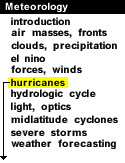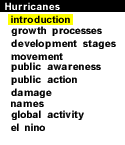
|

Graphic by: Dan Bramer
Hurricanes are cyclones that develop over the warm tropical oceans and have sustained winds in excess of 64 knots (74 miles/hour). These storms are capable of producing dangerous winds, torrential rains and flooding, all of which may result in tremendous property damage and loss of life in coastal populations. One memorable storm was Hurricane Andrew (pictured above), which was responsible for at least 50 deaths and more than $30 billion in property damage. The purpose of this module is to introduce hurricanes and their associated features, to show where hurricanes develop, and to explain the atmospheric conditions necessary for hurricane development. The Hurricane module has been organized into the following sections:
| Sections
Last Update: 09/16/99 |
Definition and Growth
Defines a hurricane and shows the regions and mechanics of hurricane development.
Stages of Development
Structure of a Hurricane
Movement
Satellites and Hurricane Hunters
Preparations
Damage and Destruction
Hurricane Tracks
How They Are Named
Global Activity
El Niño
Acknowledgments
|
The navigation menu (left) for this module is called "Hurricanes" and the menu items are arranged in a recommended sequence, beginning with this introduction. In addition, this entire web server is accessible in both "graphics" and "text"-based modes, a feature controlled from the blue "User Interface" menu (located beneath the black navigation menus). More information about the user interface options, the navigation system, or WW2010 in general is accessible from About This Server.

Land Breezes |
|

Growth Processes |



